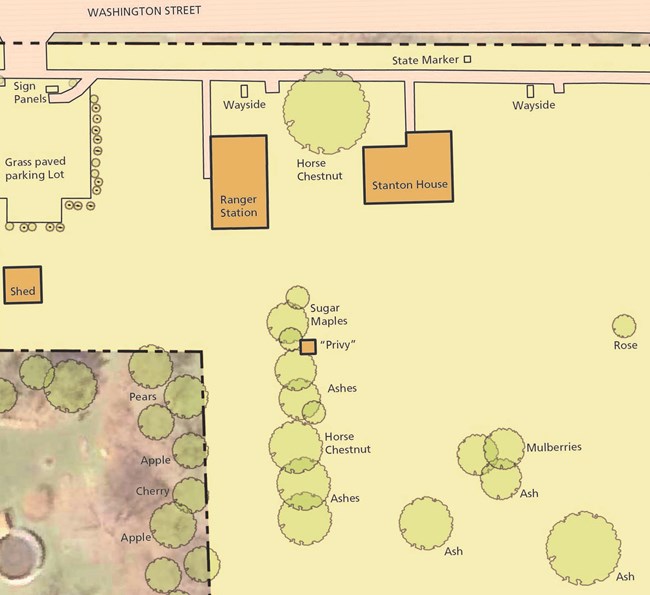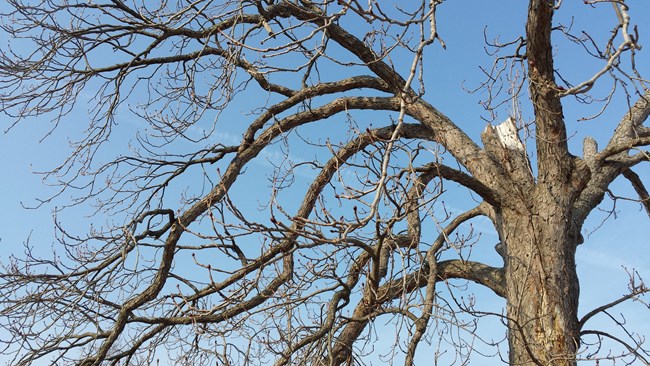Last updated: December 22, 2020
Article
Plant Profile: Horse Chestnut at Women’s Rights National Historical Park

Specimen Details
- Location: Elizabeth Cady Stanton House, Women’s Rights National Historical Park, Seneca Falls, NY
- Species: Horse chestnut (Aesculus hippocastanum)
- Landscape Use: Specimen tree
- Age: Approximately 186 years (estimated planting around 1834)
- Condition: Fair to Poor (storm damage to the crown)
- ID Number: 95070
- Measurements:
- Diameter at breast height (DBH): 22”
- Height: 35’
- Spread: 22’

NPS / Olmsted Center for Landscape Preservation
Significance
At the historic Elizabeth Cady Stanton House, home of a leading suffrage and abolition activist from 1847 to 1862, one resident of the property is still alive today. Evaluations of the house and surrounding landscape found that the European horse chestnut (Aesculus hippocastanum) located in front of the house is the only tree old enough to have been present during Elizabeth Cady Stanton’s residence at the property. The horse chestnut is estimated at nearly 190 years old, meaning it was likely planted in the 1830s.While there are few photographs of Stanton’s life at the house in Seneca Falls, New York, it is easy to imagine the young horse chestnut’s seeds and branches encouraging play among the household’s children, since Stanton was an advocate for children’s independent play and decision-making. It is equally easy to picture its large leaves creating comfortable shade for meetings of women at the “center of the rebellion,” as Stanton dubbed her home.
Stanton had many houseguests, including numerous visits by Susan B. Anthony. More than just their ideologies connected these two activist leaders – frequent letters passed between them, and, as it turns out, each viewed the same species of tree outside their home’s front windows. Susan B. Anthony resided in nearby Rochester, New York, and the earliest known photo of her house captures Elizabeth Cady Stanton and peers gathering on the lawn next to Anthony’s horse chestnut tree. While their parallel planting is likely chance, the gatherings witnessed by these two horse chestnuts are rife with similarities.
Anthony’s record of environmental activism outperforms that of Stanton, with a direct tie to the horse chestnut. Reports show that she campaigned to save the tree from being cut down and paved over by the city of Rochester. For this activism, Anthony was recognized as a “Hero of Horticulture” by the Cultural Landscape Foundation in 2007.

NPS / Women's Rights National Historical Park
Botanical Details
Horse chestnuts are popular specimen trees for lawn and street planting, in part due to showy white flowers with red or yellow markings that appear in upright clusters in late spring. The fruit consists of one or two horse chestnuts encased by a leathery light brown husk covered with sharp spines. Not to be confused with edible American chestnuts, the seeds from European horse chestnuts are not edible. Chestnuts (Castanea) are in the beech family (Fagaceae) and produce edible seeds, while horse chestnuts and buckeyes (Aesculus) are in the soapberry family (Sapindaceae) and produce poisonous seeds.Preservation Maintenance
Returning to the Elizabeth Cady Stanton House, park staff and horticulturists from the Olmsted Center for Landscape Preservation have a plan in place to preserve the historic horse chestnut tree. Considering the tree’s age, condition, and significance, this tree was genetically propagated by cuttings, which have successfully grown into young horse chestnuts that share the genetic story of the historic parent tree. Since the initial propagation, the historic tree’s condition has further deteriorated due to storm damage to the crown. The park will continue to preserve the historic tree for as long as possible, and at the appropriate time, the genetically propagated replacement tree will be planted in its place for future generations to visit.
NPS / Women's Rights National Historical Park
